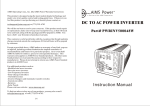Download EE 2145230 Chapter 11 Power Distribution Systems
Transcript
EE 2145230 Chapter 11 Power Distribution Systems 11.1 Introduction • Common sources of electric power used in aircraft: dc/ac alternators (generators) and aircraft’s storage battery. • A simple power distribution system consists of a basic copper conductor, called a bus bar. Each electrical loads are connected to the bus bar through a fuse or circuit breaker. • On almost all aircraft the bus bar is connected to the positive output terminal of the generator and/or battery. The negative voltage is distributed through the metal structure of the aircraft. • For any aircraft type, the distribution system will comprise the following items: busbar, protection, control, wiring and loads. 11.2 Requirements for Power Distribution Systems • General Requirements ‐ The general requirements for power distribution system on normal, utility and acrobatic aircraft can be found from Federal Aviation Administration (www.faa.gov). ‐ For commercial and other civil aircraft the requirements for the installation and approval of electrical components and materials are established by the Federal Aviation Administration (FAA) and published in Federal Aviation Regulations (FAR). ‐ The federal aviation regulations (FAR) set forth only basic guidelines upon which an aircraft’s certification is based. ‐ Electrical systems must be free of hazards in themselves, in their method of operation, and in their effects of other parts of the aircraft; and they must be installed in such a manner that they are adequately protected from fuel, oil, water, hydraulic fluid, and any other detrimental substance or condition including mechanical damage. Electrical equipment must be of a type and design adequate for its use. ‐ Among the items which must be considered in the installation of aircraft electrical systems are: (1) an electrical power source with capacity to supply the maximum electrical‐power requirements of the aircraft when all possible circuits are in operation; (2) electrical wiring (cable) for each circuit which can carry the maximum possible load for the circuit without overheating or causing an unacceptable voltage drop; (3) installation of all items of equipment and wiring in such a manner that they cannot be damaged by excessive wear, abrasion, or materials with which they could come in contact; and (4) adequate protective devices in all electrical circuits to prevent damage to the wiring and components in case of short circuits or overload. ‐ It must be shown by analysis, tests, or both that the aircraft can be operated safely in Visual Flight Rules (VFR) conditions for a period or not less than 5 min with the normal electric power sources, excluding the battery. 1 • Need for Protective Devices ‐ Short circuits can result in serious fire hazard and destruction of electric wiring and damage to electric equipment. Therefore, adequate protective devices (such as fuses, circuit breakers and cutout relays) and systems must be provided. ‐ Spare fuses must be provided for use in flight in a quantity equal to at least 50% of the number of fuses of each rating required for complete circuit protection. ‐ All fuses, circuit breakers, switches, and other electric controls in an airplane must be clearly identified so that the pilot or other member of the crew may quickly and easily perform in flight any necessary service to the unit. ‐ Each circuit for essential loads must have individual circuit protection. ‐ A master switch must be provided that will make it possible to disconnect all power sources from the distribution system. More than one master switch can be employed. • Electrical Load ‐ Electrical load of an aircraft is determined by the load requirements of the electric units or systems that can be operated simultaneously. ‐ It is essential to know the electrical loads of any aircraft . ‐ The electric power source for the aircraft has sufficient capacity to operate the additional equipment. ‐ To determine the electrical load of an aircraft, an electrical‐load analysis is made. ‐ Loads may be continuous or intermittent (operate for 2 min or less and then turn off), depending on the nature of the operation. ‐ During periods when a heavy intermittent load such as landing gear is operated, an overload will probably exist, and the overload will be met for a short time by the battery and generator together. ‐ The load condition during operation can be determined by observing the ammeter and voltmeter. ‐ When the ammeter is connected between the battery and the battery bus so that it will indicate CHARGE or DISCHARGE, it will be known that the system is not overloaded as long as the ammeter shows a charge condition. ‐ If there is an overload, the ammeter will show a discharge, and the voltmeter will give a low reading, the value of which is determined by the amount of the overload. • Electrical‐Load Analysis ‐ The electrical‐load analysis must perform to ensure that the aircraft’s electric power system will not be overloaded by the addition of new equipment. The goal is to compare the sum of all continuous electrical loads with the generator’s (alternator’s) maximum output. 2 ‐ There are two means to determine aircraft’s electrical loads: via measurement or via summation of all individual loads. ‐ Measurement method: Start the aircraft engine, and allow the battery to regain full charge, turn on all aircraft’s continuous electric equipment, and monitor the ammeter which will give the total electrical load. ‐ Summation method: Each individual electric current load must be known from aircraft service manual or from the data plate of each individual unit. When summing electrical loads, be sure to use actual current draws, not circuit breaker or fuse ratings. • A Simple Electrical System ‐ A simple electrical system for a light aircraft consists of a battery circuit, a generator circuit with associated controls, an engine‐starter circuit, a bus bar with circuit breakers, control switches, an ammeter, lighting circuits, and radio circuits. ‐ The main generator power cables are also considerably larger than the normal circuit wiring; however, they are usually smaller than the cables required to carry full battery current. This is because the battery is used for starting the engine and the starting current is very heavy. During operation of the aircraft, the battery is connected to the system but is not supplying power. Instead, it is taking power from the generator in order to maintain a charge. All the normal load currents are supplied by the generator during flight. 3 11.3 Main Distribution Systems • Single‐engine aircraft ‐ Battery bus bar schematic: The current supplied from the battery to the bus will be very high, a heavy‐duty relay or contactor is often used; the battery master switch activates the contactor when power is required on the bus. The same switch is also used for generator control. For general aviation aircraft the battery is normally used for an engine start. ‐ AC Alternator schematic: This illustrates the voltage regulator and battery master switch used for alternator control. It is normal practice for the battery charge/discharge current to be monitored via an ammeter. 4 • Twin‐engine aircraft ‐ In the basic configuration, each engine drives its own generator, and the outputs are supplied to a common battery busbar. ‐ Engine speed variations mean that one generator could be supplying more output than the other generator and so an equalizing system, using carbon pile regulators, is employed to balance the outputs. This balancing circuit provides automatic adjustment so that each generator delivers an equal output. ‐ The left and right carbon pile regulators (items 3 and 4) each have equalizing coils (items 7 and 8) wound on the same core as the voltage regulator coils (items 5 and 6). Low value resistors (items 1 and 2, typically 0.01 Ω) are fitted in each generator ground connection; these develop voltage drops in proportion to the generator output currents. Both equalizing coils are connected in series with the top end of the resistor; the system senses and adjusts the generator outputs to balance both generators at normal engine speeds. The generator outputs are connected through the reverse current relays (items 11 and 12) to the battery busbar. Equalizing circuits connect each resistor via equalizing coils and equalizing switches (items 13 and 14). When each generator has the same output, e.g. 50 A, the voltage dropped across each resistor is therefore IR = 50 × 0.01 = 0.5 V; there is no voltage difference and no current flows in the equalizing circuit, the circuit is now balanced. Over time, variations in output develop due to the mechanical differences in the regulators, e.g. carbon pile wear, contact surface resistance and mechanical variations in the armature. 5 11.4 Large Aircraft Electrical Systems ‐ ‐ Larger (commuter, business and passenger) aircraft have many more electrical systems compared with general aviation aircraft; there is s requirement for a comprehensive approach to account for potential failures of generators, wiring, etc. The management of potential failures is addressed by categorizing the various loads and then disconnecting them in accordance with a predetermined sequence. The process of switching loads off the bus is called load‐shedding; this can be achieved by automatic or manual control. These loads are connected onto specific busbars that fulfil a specific function. These can be categorized into a hierarchy as illustrated below. Connections between busbars are via heavy‐duty contactors, or breakers. Aircraft types vary, however the following categories are typical for many installations. There are three main types of distribution system architecture used on aircraft to fulfil the above: 1) Split bus system 2) Parallel system 3) Split parallel system. ‐ Essential lighting, flight control systems, and communication and navigation radios are high‐priority electrical systems. ‐ Modern large aircraft use both ac and dc electric powers. The output of a typical generator is three‐ phase 115 Vac; this is converted by transformer‐rectifier units (TRUs) where dc power (output is 28 Vdc) is needed. 6 • The Split‐Bus System ‐ This is a completely isolated twin generation system, sometimes called a non‐parallel system used on twin‐engine aircraft. ‐ The major advantage of a split‐bus system is that the generator operates independently; that is, generator output frequencies and phase relationships need not be so closely regulated. ‐ Primary power is based on two main AC integrated drive generators. An Auxiliary Power Unit (APU) generator is used as back‐up in the event of a main integrated drive generator (IDG) failure. Note that the APU is normally a constant speed device in its own right; therefore an IDG is not required. The advantage of a split‐bus system is that the generators do not need to be operating at exactly the same frequency and can be running out of phase with each other. Secondary power is derived from step‐down transformers to provide 26 V AC; transformer rectifier units (TRU) provide 28 V DC for the DC busbars and battery charging. ‐ The right and left generators feed their own busbars to which specific loads are connected. Each generator bus is connected to a transfer bus via transfer relays. In the event of a generator failure, the remaining generator (engine or APU) supplies essential loads. Control of the system is via a number of flight compartment switches, control breakers and relays arranged to connect and disconnect the generators and busbars. 7 ‐ Typical control panel features for a split bus system are shown next ; the features of this panel are: o Ammeters for the main generators to indicate load current o Ground power available when external power supply is connected o Ground power on/off switch to select ground power onto the aircraft o Transfer bus off when the transfer relay is de‐energized (either normal or transfer) o Bus off both respective generator circuit breakers (GCB) and bus tie breakers (BTB) open o Generator bus off if the respective GCB is open o APU generator bus off APU running at 95% rpm, no power from generator. • Parallel Electrical Systems ‐ The electrical distribution system on larger passenger aircraft (with three or four engines) are based on a parallel load distribution system. In this configuration, all generators are connected to their own AC load bus and a distribution bus; any generator can supply any load bus to provide equal load‐ sharing. All generator voltages, frequencies and phase relationships must be controlled to very close tolerances (must synchronize and connect in parallel by the tie bus). Any attempt to connect generators in parallel before these conditions are met could result in loss of generator power due to large circulating currents. 8 ‐ When all four GCBs and BTBs are closed; all four generators are synchronized and connected to the tie (or synchronized) distribution busbar. If one generator fails, its GCB is opened; this isolates the generator from its own load busbar. That busbar is now powered from the remaining generators. If this bus becomes overloaded, opening its GCB and BTB isolates it. With more than two generator failures, load‐shed ding is introduced. External power can be made available by one or two power supply units (or carts). The APU can also be connected onto the distribution bus. • Split Parallel System ‐ This is a flexible load distribution system for large passenger aircraft; it provides the advantages of the parallel system and maintains isolation when needed. Primary power supply features include: one IDG per engine, two APU generators and two external power connections. A split system breaker (SSB) links left and right sides of distribution system. Any generator can supply any load busbar; any combination of generators can operate in parallel. 9 • Control of the Power Distribution Systems ‐ Various components are used for both control and protection of the power distribution system: 1) Current transformers to sense current for control, protection and indication applications 2) Differential current protection to detects short‐circuits in AC generator feeder lines or busbars 3) Phase protection to protect against faults between phases, or from individual phase to ground faults 4) Breakers/contactors to trip or reconnect the circuit ‐ Load shedding can be defined as deciding on which systems to switch off and in what order this should be done to reduce the power consumption for the remaining power sources. ‐ Power manipulation on an aircraft can be done by employing solid‐state bus power control unit (BPCU). ‐ BPCU receives input information concerning system loads from load controllers. Load controllers are circuit that sense real system current and provide control signals for the generator’s constant speed drive rpm governor. ‐ On modern aircraft, the BPCU performs control, test, protection and fault identification functions. Each aircraft typically contain two BPCUs for redundancy in the event of a failure. ‐ Samples of typical power distribution on an aircraft. References: Textbooks # 1 and # 2 EE 2145230 Aircraft Electricity and Electronics Asst. Prof. Thavatchai Tayjasanant, Ph.D. 10
















